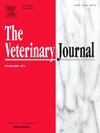A novel lytic Seuratvirus phage CABI-SEA 2301 with broad host range against multidrug-resistant avian pathogenic Escherichia coli
IF 3.1
2区 农林科学
Q1 VETERINARY SCIENCES
引用次数: 0
Abstract
Multidrug-resistant avian pathogenic Escherichia coli (MDR-APEC) causes high mortality in newborn chickens, leading to significant economic losses for poultry industry worldwide. The present study proposes an effective alternative strategy to control APEC infections by using bacteriophage specific to MDR-APEC. Lytic phage CABI-SEA 2301 isolated from a chicken faecal sample collected at a commercial poultry farm using the double layer agar overlay technique was classified as a novel species in the genus Seuratvirus, subfamily Queuovirinae. Genome sequencing unveiled that the selected phage consisted of a double-stranded DNA molecule with 61,452 base pairs and a GC content of 38 %, with no toxins, virulence, and antimicrobial resistance. Phage CABI-SEA 2301 demonstrated a broad host range, lysing 68 % of 50 MDR-APEC clinical isolates obtained from E. coli lesions at poultry farms. A high adsorption rate to the host was exhibited with 77 % within 10 min. One-step growth analysis showed that phage CABI-SEA 2301 had a latent period of 30 min with a burst size of 522 PFU/cell. Phage-infected MDR-APEC isolate CABI-SEA 2349 at the lowest multiplicity of infection of 0.01 showed a significant decrease in the bacterial growth after 4 h post-infection. Scanning electron microscopy further confirmed abnormal cellular morphology after treatment. Moreover, phage CABI-SEA 2301 could effectively inhibit the bacterial biofilm formation. Interestingly, the phage survived in mimic simulated chicken gastrointestinal conditions (96.67 ± 4.71 %) and revealed good stability under temperature between −80–50 ˚C and pH 4–12. The findings highlight the potential of the phage CABI-SEA 2301 as a biocontrol agent against MDR-APEC in the commercial farms.
一种新的具有广泛宿主范围的抗多重耐药禽致病性大肠杆菌的溶性天然病毒噬菌体CABI-SEA 2301。
耐多药禽致病性大肠杆菌(MDR-APEC)在新生鸡中造成高死亡率,给全球家禽业造成重大经济损失。本研究提出了一种有效的替代策略,通过使用耐多药APEC特异性噬菌体来控制APEC感染。利用双层琼脂覆盖技术从某商业家禽养殖场采集的鸡粪便样本中分离到一株裂解噬菌体CABI-SEA 2301,该噬菌体被归类为queue - virinae亚科Seuratvirus属的一种新种。基因组测序结果表明,所选噬菌体由一个双链DNA分子组成,具有61452个碱基对,GC含量为38%,无毒、无毒、耐药。噬菌体CABI-SEA 2301表现出广泛的宿主范围,能够分解从家禽养殖场大肠杆菌病变中获得的50株耐多药- apec临床分离株中的68%。10min内对寄主的吸附率高达77%。一步生长分析表明,噬菌体CABI-SEA 2301潜伏期为30min,爆发量为522 PFU/细胞。感染噬菌体的MDR-APEC分离物CABI-SEA 2349的最低感染倍数为0.01,感染后4h细菌生长显著下降。扫描电镜进一步证实治疗后细胞形态异常。此外,噬菌体CABI-SEA 2301能有效抑制细菌生物膜的形成。有趣的是,该噬菌体在模拟鸡胃肠道条件下的存活率为96.67±4.71%,在-80-50˚C和pH 4-12范围内表现出良好的稳定性。这些发现突出了噬菌体CABI-SEA 2301作为耐多药apec生物防治剂在商业养殖场的潜力。
本文章由计算机程序翻译,如有差异,请以英文原文为准。
求助全文
约1分钟内获得全文
求助全文
来源期刊

Veterinary journal
农林科学-兽医学
CiteScore
4.10
自引率
4.50%
发文量
79
审稿时长
40 days
期刊介绍:
The Veterinary Journal (established 1875) publishes worldwide contributions on all aspects of veterinary science and its related subjects. It provides regular book reviews and a short communications section. The journal regularly commissions topical reviews and commentaries on features of major importance. Research areas include infectious diseases, applied biochemistry, parasitology, endocrinology, microbiology, immunology, pathology, pharmacology, physiology, molecular biology, immunogenetics, surgery, ophthalmology, dermatology and oncology.
 求助内容:
求助内容: 应助结果提醒方式:
应助结果提醒方式:


